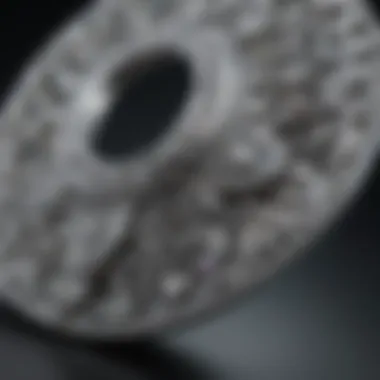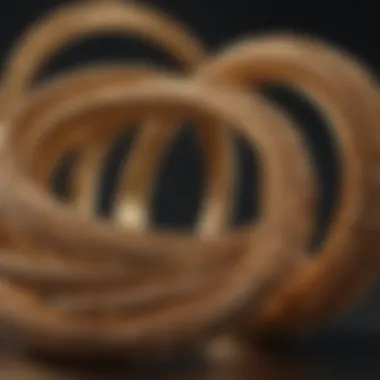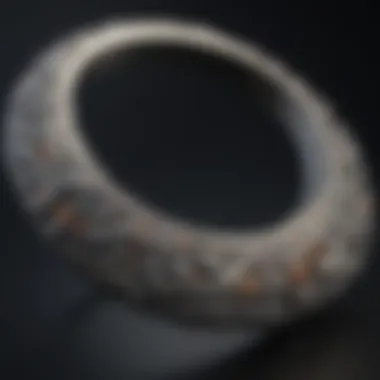Discovering the Intricacies of Jewelry Making Metals: A Comprehensive Guide


Rock and Fossil Identification
In the realm of jewelry making, understanding the characteristics of various metals is akin to identifying distinct types of rocks and fossils. Just as rocks and fossils hold unique traits that aid in their recognition, metals boast individual properties that define their appeal in jewelry craftsmanship. Tools play a crucial role in this identification process, allowing artisans to discern the nuances that differentiate one metal from another.
Crafting Techniques and Best Practices
When it comes to crafting exquisite jewelry pieces, mastery of techniques and adherence to best practices are paramount. Similar to the ways in which prime collecting sites are sought after in the rock and fossil world, jewelry artisans must also navigate the landscape of metals to uncover the most optimal practices for shaping and molding these materials into timeless creations. From cutting-edge technology to age-old methods, finding the right approach can elevate the art of jewelry making to new heights of excellence.
Aesthetics and Design
Just as rocks and fossils are intricately preserved and creatively displayed to showcase their beauty, metals in jewelry making also undergo processes to maintain their allure over time. By exploring innovative techniques for preserving metals and discovering fresh perspectives on presenting these materials, artisans can infuse their jewelry pieces with a sense of timelessness and sophistication.
Trends and Innovations
Much like the geological world undergoes constant evolution and unveiling of new discoveries, the field of metals in jewelry making also experiences shifts in trends and innovations. Delving into the geological insights of metal sourcing and the historical significance of certain metals can provide invaluable inspiration for crafting jewelry pieces that resonate with both tradition and modernity. By staying attuned to the pulse of the industry, artisans can create jewelry masterpieces that stand out in a dynamic and ever-changing landscape.
Introduction
In the vast world of jewelry making, the selection of metals plays a pivotal role in defining the quality, durability, and aesthetic appeal of the final pieces. This section serves as a gateway into the intricate domain of metals in jewelry craftsmanship, shedding light on their historical significance, evolution in design techniques, and essential role in shaping exquisite adornments. By unraveling the complexities and nuances of various metals used in jewelry making, readers will gain a profound understanding of the significance of metal selection in creating timeless and enchanting pieces.
Brief Overview of Metals in Jewelry Making
History and Significance
Exploring the history and significance of metals in jewelry making provides a profound insight into the evolution of adornment throughout civilizations. The unique blend of artistry, cultural traditions, and technological advancements has shaped the way metals are revered in crafting jewelry pieces. From the ancient civilizations where metals symbolized status and wealth to the modern era where they stand as a blend of tradition and contemporary design, delving into their historical context unveils a rich tapestry of human creativity and expression.
Evolution of Metalwork in Jewelry
The evolution of metalwork in jewelry mirrors the advancements in craftsmanship techniques and design aesthetics. From intricate filigree work to avant-garde experimental designs, the metamorphosis of metalwork showcases the creative ingenuity of artisans across eras. By tracing the lineage of metalwork techniques, one can appreciate the fusion of traditional artistry with modern innovation, resulting in a diverse range of jewelry styles that cater to varied tastes and preferences.
Role of Metals in Crafting
Metals serve as the backbone of jewelry crafting, offering not just structural support but also acting as a canvas for artistic expression. The intrinsic properties of metals, such as their malleability, hardness, and color palettes, influence the design possibilities and durability of jewelry pieces. Understanding the fundamental role metals play in crafting empowers artisans to push the boundaries of conventional design and delve into realms of creativity that transcend the ordinary, culminating in unique and compelling jewelry creations.
Purpose of the Article
Educating on Metal Choices
Educating readers on the vast array of metal choices available in jewelry making empowers them to make informed decisions based on their design preferences, budget considerations, and desired aesthetic outcomes. By delving into the characteristics, pros, and cons of each metal type, this article aims to impart valuable knowledge that aids in selecting the most suitable metal for crafting jewelry pieces that align with individual styles and visions.
Highlighting Characteristics
Highlighting the unique characteristics of different metals illuminates their distinctive allure and functional properties in jewelry making. Whether it's the radiant sheen of gold, the versatility of silver, or the industrial chic of titanium, each metal boasts its own set of attributes that contribute to the overall visual impact and longevity of the finished piece. By accentuating these traits, readers can develop a deeper appreciation for the intrinsic beauty and significance of metals in jewelry design.


Guiding Selection Process
Guiding readers through the selection process of metals in jewelry making involves combining practical insights with creative considerations. From understanding how metal choice influences gemstone pairing to evaluating the wearability of specific metals for everyday use, this section aims to provide a roadmap that streamlines the decision-making process for aspiring jewelry makers. By offering guidance on factors such as affordability, maintenance, and design compatibility, readers can navigate the vast landscape of metal options with confidence and clarity.
Types of Metals: A Comprehensive Overview
Metals play a pivotal role in the realm of jewelry making, each type offering distinct characteristics and benefits. Understanding the various types of metals is essential for jewelry enthusiasts looking to elevate their craft and create timeless pieces. By delving into precious, semi-precious, and base metals, artisans can unlock a world of creativity and versatility.
Precious Metals
Gold
Gold stands as a symbol of luxury and sophistication in the jewelry industry, renowned for its timeless allure and enduring value. The key characteristic of gold lies in its brilliance and durability, making it a popular choice for crafting exquisite pieces that withstand the test of time. Its unique feature of being highly malleable allows artisans to unleash their creativity with intricate designs, although this malleability also makes it prone to scratching. Despite this, the allure of gold remains unmatched, making it an indispensable metal in jewelry making.
Silver
Silver exudes elegance and charm, prized for its versatility and affordability in jewelry crafting. The key characteristic of silver is its lustrous appearance, adding a touch of sophistication to any design. Its affordability makes it a popular choice for both traditional and contemporary pieces, although its tendency to tarnish may require regular maintenance. The unique feature of silver lies in its ability to complement a wide range of gemstones, offering endless creative possibilities for artisans.
Platinum
Platinum reigns as the king of metals, known for its rarity, durability, and brilliance. The key characteristic of platinum is its strength and resistance to wear, making it an ideal choice for high-end jewelry with a modern aesthetic. Its unique feature of being hypoallergenic sets it apart from other metals, appealing to those with sensitive skin. While platinum comes at a premium price, its unparalleled beauty and longevity make it a coveted metal for crafting exquisite jewelry pieces.
Semi-Precious Metals
Copper
Copper embodies warmth and depth, adding a rustic charm to jewelry designs. The key characteristic of copper is its versatility and affordability, making it a popular choice for artisanal creations. Its unique feature lies in its ability to develop a rich patina over time, enhancing its aesthetic appeal. However, copper may require regular cleaning to maintain its luster, offering a vintage allure to jewelry pieces.
Brass
Brass exudes a classic appeal with its golden hue and versatile nature. The key characteristic of brass is its strength and corrosion resistance, making it suitable for intricate designs. Its unique feature lies in its affordability and ability to mimic the look of gold, providing artisans with a budget-friendly option for creating stylish jewelry pieces. However, brass may tarnish over time, requiring periodic polishing to retain its shine.
Bronze
Bronze carries a timeless appeal with its earthy tones and historical significance in jewelry making. The key characteristic of bronze is its strength and durability, perfect for crafting enduring pieces. Its unique feature lies in its rich history and cultural significance, adding a sense of heritage to jewelry designs. However, bronze may oxidize over time, developing a natural patina that enhances its charm and character.
Base Metals
Steel
Steel embodies strength and resilience, making it a popular choice for contemporary jewelry designs. The key characteristic of steel is its durability and scratch resistance, ideal for everyday wear. Its unique feature lies in its industrial appeal, adding a modern touch to jewelry pieces. However, steel may require occasional polishing to maintain its shine and prevent corrosion, offering a sleek and edgy aesthetic to jewelry enthusiasts.
Nickel
Nickel offers a unique blend of affordability and versatility in jewelry making. The key characteristic of nickel is its hypoallergenic properties, making it a safe choice for those with sensitivities. Its unique feature lies in its ability to create vibrant finishes, adding a pop of color to jewelry designs. However, nickel may tarnish over time, requiring regular cleaning to preserve its appearance and appeal.


Titanium
Titanium represents innovation and modernity in the world of jewelry, known for its exceptional strength and lightweight nature. The key characteristic of titanium is its hypoallergenic properties and bio-compatibility, making it ideal for those with skin sensitivities. Its unique feature lies in its resistance to corrosion and wear, offering a durable and low-maintenance option for jewelry enthusiasts. Despite its strength, titanium can be challenging to work with due to its hardness, requiring specialized techniques for crafting intricate designs that exude a contemporary allure.
Properties of Metals
Metals play a crucial role in jewelry making, offering a wide range of unique properties that impact the overall design and durability of the pieces. Understanding the properties of metals is essential for jewelry enthusiasts looking to create lasting and visually appealing pieces. By exploring the key elements of metals such as durability, strength, color, luster, malleability, and workability, artisans can choose the most suitable metal for each design.
Durability and Strength
Impact on Jewelry Longevity
Durability and strength are essential factors to consider when selecting metals for jewelry fabrication. Metals with high durability, such as platinum and titanium, ensure that the jewelry withstands daily wear and tear, providing longevity to the piece. This longevity is crucial for creating timeless jewelry that retains its beauty over the years. The resilience of these metals makes them a popular choice among jewelers for crafting durable and long-lasting pieces.
Resistance to Wear
Resistance to wear is another vital aspect of metal selection in jewelry making. Metals like stainless steel and nickel offer excellent resistance to tarnishing and corrosion, ensuring that the jewelry maintains its pristine appearance even after prolonged use. This resistance enhances the overall quality of the jewelry, making it a desirable choice for consumers seeking lasting and resilient pieces. However, some metals may be prone to wear under specific conditions, requiring careful consideration during the selection process.
Color and Luster
Aesthetic Appeal
The color and luster of metals contribute significantly to the aesthetic appeal of jewelry pieces. Gold exudes a luxurious warmth, while silver offers a classic and elegant shine. The choice of metal color can dramatically impact the overall design of the jewelry, influencing its visual appeal and perceived value. Different metals provide distinct aesthetic qualities, allowing artisans to create diverse and captivating jewelry designs that cater to varied tastes and preferences.
Maintenance Considerations
Maintenance considerations are essential when selecting metals for jewelry, as different metals require varying levels of care and upkeep to preserve their luster and appearance. While some metals, like platinum, are low-maintenance and resistant to tarnishing, others, such as copper, may require regular polishing to maintain their shine. Understanding the maintenance requirements of each metal helps artisans and consumers make informed decisions, ensuring that the jewelry stays radiant and beautiful for years to come.
Malleability and Workability
Forming Techniques
The malleability and workability of metals determine their suitability for different jewelry-making techniques. Metals like gold and silver are highly malleable, allowing artisans to craft intricate designs and delicate details with ease. Understanding the forming techniques specific to each metal enables jewelers to explore a diverse range of design possibilities, from elaborate filigree work to bold sculptural elements. This versatility in forming techniques empowers artisans to create unique and visually striking pieces that showcase the beauty and craftsmanship of metal.
Suitability for Intricate Designs
The ability of metals to withstand intricate designs is a crucial factor in jewelry making, particularly for pieces that feature detailed patterns or complex structures. Metals that offer high workability, such as brass and bronze, enable artisans to execute intricate designs with precision and finesse. This suitability for intricate designs opens doors to unlimited creative possibilities, allowing artisans to push the boundaries of traditional jewelry making and innovate with captivating and distinctive pieces. However, the workability of metals can also pose challenges in shaping and forming certain designs, requiring skill and expertise to achieve the desired aesthetic outcome.
Best Practices in Using Metals
In the realm of jewelry making, understanding the best practices for utilizing metals is paramount to achieving excellence in craftsmanship. The importance of this topic lies in its ability to guide artisans in selecting the most suitable metals for their designs, ensuring both aesthetic appeal and durability are met harmoniously. By delving into the specific elements of metal selection, jewelry enthusiasts can elevate their creations to new heights. Not only does focusing on best practices enhance the overall quality of the piece, but it also influences aspects such as wearability, longevity, and the visual impact of the jewelry.
Choosing the Right Metal for the Design


Matching Metal to Gemstones
When it comes to matching metals to gemstones in jewelry making, the harmonious blend between the two elements is crucial in achieving a cohesive and visually appealing design. Metal selection plays a vital role in enhancing the color, brilliance, and overall aesthetics of the gemstones, highlighting their natural beauty. This meticulous alignment between metal and gemstone ensures that the final piece exudes elegance and sophistication, captivating the beholder with its exquisite combination.
Considering Wearability
Considering the wearability of metals in jewelry design is essential for creating pieces that not only look stunning but are also practical for everyday wear. Factors such as hardness, resistance to tarnishing, and maintenance requirements should be carefully evaluated when choosing metals for jewelry. By selecting metals known for their durability and longevity, artisans can offer their clients pieces that can withstand the test of time without compromising on style or quality.
Techniques for Metalworking
Soldering and Joining
Soldering and joining techniques are fundamental aspects of metalworking that contribute significantly to the structural integrity and overall aesthetics of the jewelry piece. The ability to seamlessly join metal components through soldering allows artisans to create intricate and complex designs with precision and finesse. This technique not only reinforces the durability of the piece but also enables the artist to craft unique and custom-made jewelry that showcases their exceptional skill and artistry.
Finishing and Polishing
The finishing and polishing of metals are vital steps in the jewelry making process that enhance the final look and feel of the piece. By meticulously refining the surface of the metal, artisans can achieve a smooth texture, impeccable shine, and flawless appearance that elevates the overall aesthetic appeal of the jewelry. Finishing and polishing not only add a touch of refinement to the piece but also serve to protect the metal from tarnishing and environmental damage, ensuring the longevity and beauty of the jewelry.
Maintenance and Care Tips
Cleaning Methods
Proper cleaning methods are essential for maintaining the luster and brilliance of metal jewelry over time. Different metals require specific cleaning techniques to prevent tarnishing or deterioration, taking into account factors such as composition, hardness, and surface finish. By following the appropriate cleaning procedures, jewelry enthusiasts can preserve the beauty of their pieces and ensure that they retain their original luster and shine for years to come.
Storage Practices
Effective storage practices are paramount in preserving the quality and appearance of metal jewelry when not in use. Proper storage prevents scratches, tarnishing, and other damages that can occur from improper handling or exposure to elements. By storing jewelry in designated compartments or pouches, separated from other pieces to avoid friction and scratches, individuals can safeguard their precious metals and gemstones, maintaining their pristine condition for generations to come.
Conclusion
Recap of Key Points
Importance of Metal Selection
The meticulous process of choosing the appropriate metal for jewelry making cannot be understated. The metal selected sets the foundation for the entire piece, influencing its durability, appearance, and overall quality. Whether opting for precious metals like gold or silver, or exploring the characteristics of base metals like steel or titanium, each metal type brings its own unique allure to the jewelry piece. Understanding the distinct properties of each metal helps in enhancing the design and craftsmanship of jewelry, catering to different styles and preferences.
Craftsmanship Impact
Craftsmanship plays a pivotal role in jewelry making, as it influences not only the visual appeal but also the durability and wearability of the final piece. The intricate art of working metals requires skill and precision, especially when it comes to techniques like soldering, joining, and polishing. The craftsmanship imparted during the metalworking process adds value to the jewelry piece, making it a true work of art that reflects the creativity and expertise of the maker.
Encouragement for Experimentation
Experimentation in jewelry making opens up a realm of creative possibilities, allowing artisans to push boundaries and explore innovative designs. By embracing experimentation, jewelry makers can break free from conventional norms and traditional designs, leading to the creation of unique and standout pieces that captivate the beholder. Furthermore, embracing metal diversity enables artisans to blend different metals creatively, adding depth and dimension to their creations.
Pushing Creative Boundaries
Pushing creative boundaries in jewelry making involves thinking outside the box and exploring unconventional ideas. By challenging traditional design norms and experimenting with new techniques, artisans can embark on a journey of self-expression and innovation. This creative freedom not only enhances the artistic value of the jewelry piece but also fosters a sense of individuality and uniqueness that sets it apart from the rest.
Embracing Metal Diversity
Embracing metal diversity in jewelry making allows artisans to amalgamate various metals to create visually stunning pieces. Mixing metals not only adds a dynamic element to jewelry design but also imbues the pieces with a rich contrast and texture. By embracing metal diversity, artisans can cater to a diverse range of tastes and preferences, catering to a wider audience and showcasing their versatility in design.







